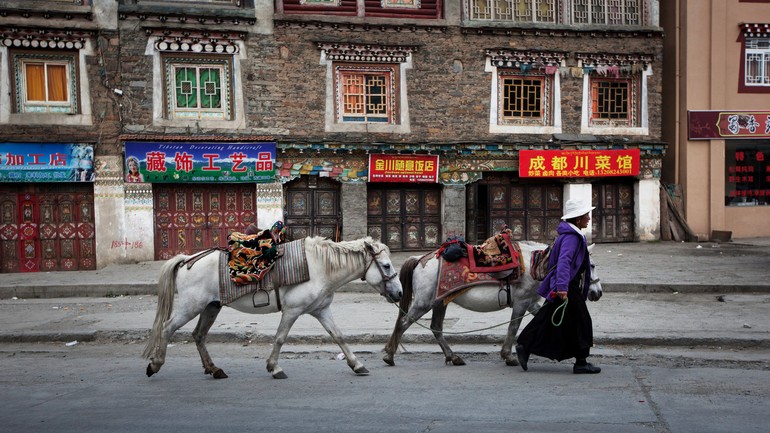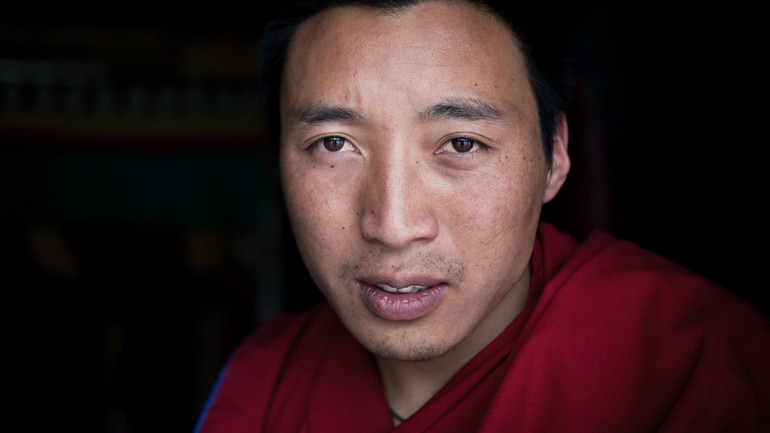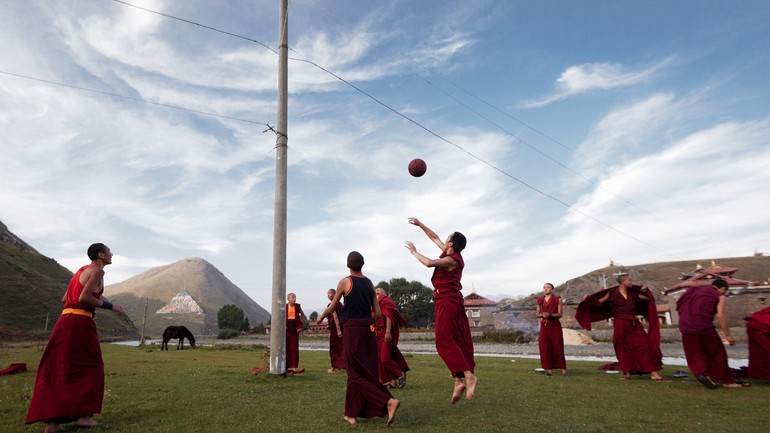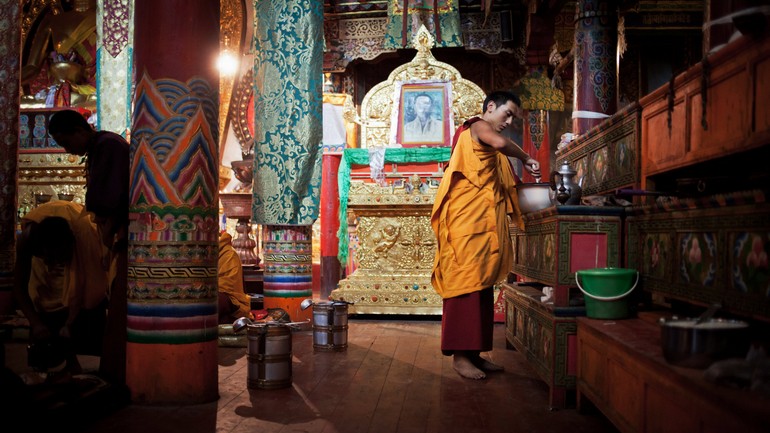High on the Tibetan plateau, a few dozen red-robed monks of the Lhagang Monastery sat facing one another, rocking back and forth as they chanted with faces turned upward, to the heavens.
在西藏高原的塔公寺,几十位穿着藏红袍子的僧人面对面坐着,前后微微摇晃着,仰天吟诵佛经。
In the flickering candlelight of the monastery's dim main chamber, they then built small pyramids of incense to place throughout the building, adorned with golden Buddhas, and at the center of Tagong.
寺庙位于塔公镇的正中央,阴暗的正殿里有几个镀金的佛像;僧人们借着闪烁的烛光,在各处堆起一些金字塔形的香堆。
Outside, under the harsh noon sun, the monks mingled with the mainly Buddhist and ethnically Tibetan residents of the frontierlike town, population 8,000, which despite its makeup is in Sichuan province, China.
外面,在正午炙热的阳光下,僧人们在和当地的居民交谈;这些居民全是藏族人,其中大多数是佛教徒。这个偏远的小镇有8000多个居民,尽管此地居住的都是藏民,但是它属于中国的四川省。
I had been in Tagong just an hour, after arriving in a small, dusty van that had bounced along rutted roads for the three-hour journey from the nearby city of Kangding, its engine whining as we ascended and descended steep mountain passes.After checking into one of the colorful guesthouses across the central square from the monastery, I had simply followed the brightly dressed monks into the main hall to witness one of their several daily worship sessions.
在崎岖的山路上颠簸了3个小时之后,我从附近的康定市来到塔公镇,此时已经逗留了一个钟头。我来时乘坐的是一辆落满灰尘的小客车,爬过一个个陡峭的山口时,引擎发出阵阵悲鸣。寺庙门前有个中央广场,广场对面有几家五颜六色的客栈;我在其中一家办理入住之后,就跟着穿着鲜艳的袍子的僧人来到正殿,目睹了他们的一场日常礼拜仪式。

Tagong, whose altitude of about 12,000 feet makes it one of the highest towns in the world, offers an unfettered window onto the Tibetan people and culture. The region was part of Tibet until 1955, and its remoteness — to get there, you must take a single winding road several hours from the bustling provincial capital, Chengdu — has insulated it against significant change. The place has a closed-off feel, with a slow-paced existence that revolves around the major Tibetan monastery and its 60 or so resident monks. And it was easier than traveling to the Tibet Autonomous Region, which in addition to the visa and passport required to visit China, also requires a special entry permit that doesn't promise unrestricted travel.
塔公镇的海拔在12000英尺左右,是世界上海拔最高的小镇之一,在这里,你可以尽情了解藏族人和藏族文化。1955年之前,这里属于西藏,它非常偏僻,从繁华的省会成都到这里只有一条蜿蜒曲折的道路,开车要好几个小时,因此许久以来没有发生太大变化。这里给人一种与世隔绝的感觉,生活节奏很慢,生活的重心就是这座重要的藏族寺庙和里面的大约60名常驻僧人。来这里旅行比去西藏自治区容易,因为要去西藏,你除了要有进入中国所需的签证和护照之外,还需要一个特殊的入藏许可证,而这个许可证并不保证你能无拘无束地旅游。
That sort of unfettered access was my reason for going, and two hours into my stay it was clear that Tibetan culture and Buddhism remain at the heart of life in Tagong, albeit with slight tweaks to accommodate the few thousand foreign visitors who make the journey each year: a few guesthouses, yak-cheese pizza and arranged horse-trekking trips into the plains outside of town.
出入不受限制,是我选择来这里的原因。到这里两个小时之后,我就清楚地知道:藏族文化和藏传佛教仍是塔公人生活的中心,不过也有一些小小的变化:为了给每年到这里来的几千名外国游客提供食宿,这里也出现了几个客栈,出现了牦牛肉奶酪披萨,也有人安排马车供游客到镇外的平原上游览。
Tagong itself is just a blip on the map: a stretch of ornate buildings leading to the gates of the monastery, all surrounded by endless peaks and plains. A few minivans leave or arrive throughout the day, offering seats to destinations as far away as Chengdu for about 120 renminbi, but the rest of the time a horse being ridden up the main street is as likely a sight as a passing car.
塔公镇在地图上就是个小点儿:寺庙中有一串华丽的建筑,周围是数不清的山峰和平原。一天之中,时不时地有几辆小客车出入小镇,搭乘这样的小客车到成都大约需要120元人民币;除此之外,在小镇正中的大街上,骑马的人可能和开车的人一样多。
Once in the recesses of Lhagang Monastery you can see monks devoting themselves to their faith with a calm assurance; across a wide river that runs alongside the town young apprentice monks study Buddhism at a monastic school; and up on a nearby hill, a handful of hermit monks live in silent worship.
在塔公寺深处,可以看到僧人们带着平静的笃定,全身心地投入到自己的信仰之中;一条宽阔的大河在小镇旁流过,年轻的学徒们在河对岸的僧侣学校里学习佛教;在附近的一座小山上,几位隐居僧人在安静的膜拜中度日。

"We have over a hundred young novices studying Buddhism who will eventually join us in becoming monks,'' Dhondoup, a fresh-faced 25-year-old monk said to me in English as we stood on a shaded platform overlooking the courtyard of the monastery after the noon service.
“我们有100多名年轻的新学徒在学习佛教,他们最终会加入到我们中间来,成为僧人,”一位名叫Dhondoup的僧人用英语对我说。他今年25岁,有着年轻的面庞。当时正午的礼拜仪式刚刚结束,我们站在一个阴凉的阳台上,俯瞰寺庙的庭院。
In front of us, part of the monastery was undergoing construction to house these new recruits; a new two-story dormitory was being added. Bags of cement lay within the grounds, and amid the debris were dented 10-foot-high prayer wheels, their Tibetan text covered in dust. There has been a monastery in Tagong since A.D. 652, when the Tibetan king Songtsen Gampo built the last of a series of 108 monasteries he had ordered constructed across his kingdom. Over the next millennium and a half the monastery rose and fell in importance, changing allegiance several times to different Buddhist sects before its destruction during the Cultural Revolution. In the 1980s work began on rebuilding the monastery, and today's temple is slowly returning to some of its former glory and size.
在我们面前,寺院有一部分正在建设之中,为的是给这些新僧人们提供住处,包括一座新盖的两层宿舍。一袋袋水泥堆在地上,一片瓦砾之中,矗立着几个有凹痕的10英尺高的转经筒,上面的藏语文字落满了灰尘。从公元652年起,这里就有一座寺庙;藏王松赞干布下令在他的王国里建设108座寺庙,这就是最后一座。在之后的1500年里,这座寺庙的重要性时升时降,曾效忠于几个不同的佛教派别,直到文化大革命期间被毁。二十世纪80年代,这座寺庙开始重建,如今它正在慢慢重现从前的辉煌和规模。
As I wandered the halls and chambers, staring up at the many gold Buddha statues surrounding the wall, the newness of the physical structure seemed immaterial. This visit was more about the monks than the monastery.
我在殿堂里徘徊、仰望墙壁周围那些镀金佛像时,意识到新奇的建筑对我来说好像不是那么重要。比起寺庙,我更关注的是这里的僧人。
Though all Tibetan Buddhists, they were a varied group. In one of the side reliquaries off the main hall, an aged monk smiled as I entered, and led me around the small, candlelit room where he has lived for the last three years, sleeping on a small cot. Stopping at one point, he showed me a picture of himself next to the Dalai Lama. “We are all Buddhist and he is our leader,'' he said to me in Chinese.
虽然都是藏传佛教教徒,他们是个多样化的群体。我走进主殿旁的一个侧殿,一位年长僧人对我微微一笑,领着我在这个小小的、用蜡烛照明的房间里转了一圈;过去的三年,他就住在这里,睡在一张小床上。我们一度停下脚步,他给我看了一张他和达赖喇嘛的合影,用中文对我说:“我们都是佛教徒,他是我们的领袖。”

Later in the afternoon I spotted a group of young monks playing basketball using a hoopless telephone pylon as a net on a grassy field across the town's river, their robes billowing around them. There was no bridge in sight, but I removed my shoes to cross the ice-cold, knee-deep water. On the other bank I was quickly invited to join the game.
傍晚时分,我看到河对岸的草地上有一群年轻的僧人在打篮球,袍子上下翻飞。他们用一个没有外环的电缆塔当球篮。我没有看到桥,所以就脱了鞋,趟过及膝深的冰冷的河水。我一到对岸,他们马上邀请我加入游戏。
“We try to play basketball every day before our 6 p.m. studies,'' said Laozang Tsere, a gregarious 18-year-old novice born in a nearby village.
“每天下午6点学习之前,我们都尽量来打篮球,”一位名叫Laozang Tsere的僧人对我说,他出生在附近的村子,今年18岁,非常开朗。
A few minutes after I joined the game, a bell sounded. The novices quickly checked that their robes were on straight before heading back to their studies.
我加入游戏之后不到几分钟,钟声就响了。新学徒们马上整理好自己的僧袍,回去学习。

Class was in session for an even younger group of devotees in the main hall of the Sakya Monastic School, a smaller version of the main monastery, where boys sat crossed-legged on long rows of dark-red cushions, each facing another student. They debated Buddhist texts, gesturing to make their points. Dhondoup had explained to me that the novices study the finer points of Buddhist logic, philosophy and discourse in the hillside school for seven years before being allowed to join their brethren in Lhagang.
萨迦佛学院跟塔公寺格局类似,不过规模较小。在佛学院的正殿里,一群年龄更小的信徒们正在上课。他们两人一组,面对面盘腿坐在一长排深红色的坐垫上。他们研讨佛经,要发言时举手示意。Dhondoup曾跟我说过,新学徒们在山坡上的学校里学习佛家因明、佛理和佛经中的精髓,学完七年,才能成为塔公寺的僧人。
Sometime during the debates, I sneaked out of a side door and headed up a small path through a forest of multicolored prayer flags to the simple hillside homes of several hermit monks. From their dwellings the town below appeared even smaller, dwarfed by vast snowy peaks in the distance. In the foreground there was little but wide expanses of pastureland and other small hills adorned with colorful Buddhist prayer flags, placed there over the years by the monks and townspeople.
研讨还在进行着,我悄悄从侧门溜出去,沿着小径向上走,穿过一片五彩的经幡,来到山坡上几位隐居僧人的简陋寓所旁。从这里向下看,小镇在远处白雪皑皑的宏伟山峰的映衬下,显得更加渺小。前面是一片开阔的小牧场和几座飘扬着五彩经幡的小山,这些经幡是僧人和小镇居民多年来不断挂上去的。
As I arrived outside of one door, a hermit beckoned me in, and, without uttering a word showed me around his small home, filled with Buddhas. Most of the room was taken up by the statues and Tibetan texts, with a small curtained-off area for him to sleep in. Back in town, the streets were emptying as the evening drew near; soon the monks — who must rise for 6 a.m. prayers — and locals had gone home. Viewed from this town perched on the roof of the world, with little in the way of light pollution save from a few guesthouse windows, the stars that glittered above the monastery were nothing short of majestic. That evening I dwelled on the seemingly simple lives of the monks: their faith, their warmth and their absence of 21st-century distractions. It may be facile to assume that they had found fulfillment, but it was hard to shake the impression that I'd met a group of people who, having long ago discovered a few of the secrets to a content life, existed outside of time.
我走到其中一扇门外,里面的隐居僧人招手让我进去,他什么也没说,只是带我参观了他的小屋,里面全是佛像。房间的大部分空间被佛像和藏文书籍占满了,他睡觉的地方用帘子遮着。我回到小镇的时候,夜色即将降临,街上人迹稀少,很快,僧人们和当地人都回家了,僧人们必须早上6点起床做早课。这个栖息在世界屋脊上的小镇几乎没有受到灯光的污染,只有几家客栈的窗户透出灯光,所以寺庙上空闪烁的群星看起来非常壮观。那天晚上,我品味着僧人们看似简单的生活:他们拥有信仰与热情,他们置身于21世纪的纷纷扰扰之外。假如藉此便认为他们已找到生存的意义,也许显得太过肤浅;但是我很难动摇自己的这个印象:我遇到的这群人,他们存在于时间之外,他们很久以前就发现了实现完满人生的一些秘密。



 闽公网安备 35020302035673号
闽公网安备 35020302035673号
0 responses on "Sichuan's Tibetan Corner, Outside of Time"